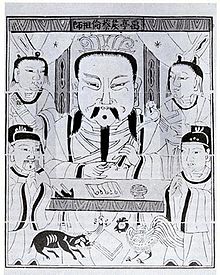
Back تساي لون Arabic تساى لون ARZ Çay Lun Azerbaijani Cai Lun BAN Цай Лунь Byelorussian Цай Лун Bulgarian ཚའེ་ལུན། Tibetan Cai Lun Catalan چای لون CKB Cchaj Lun Czech
Cai Lun | |
|---|---|
| 蔡伦 | |
 | |
| Born | c. 50–62 CE |
| Died | 121 CE (aged 59–71) Luoyang, Han Empire |
| Occupations | Eunuch court official
Court positions
|
| Known for | Development of paper and papermaking |
| Cai Lun | |||||||||||||||||||||||||||||||||||||||
|---|---|---|---|---|---|---|---|---|---|---|---|---|---|---|---|---|---|---|---|---|---|---|---|---|---|---|---|---|---|---|---|---|---|---|---|---|---|---|---|
 Cai's name in Traditional (top) and Simplified (bottom) Chinese characters | |||||||||||||||||||||||||||||||||||||||
| Traditional Chinese | 蔡倫 | ||||||||||||||||||||||||||||||||||||||
| Simplified Chinese | 蔡伦 | ||||||||||||||||||||||||||||||||||||||
| |||||||||||||||||||||||||||||||||||||||
| Jingzhong (courtesy name) | |||||||||||||||||||||||||||||||||||||||
| Traditional Chinese | 敬仲 | ||||||||||||||||||||||||||||||||||||||
| Simplified Chinese | 敬仲[4] | ||||||||||||||||||||||||||||||||||||||
| |||||||||||||||||||||||||||||||||||||||
Cai Lun (Chinese: 蔡伦; courtesy name: Jingzhong (敬仲); c. 50–62 – 121 CE), formerly romanized as Ts'ai Lun, was a Chinese eunuch court official of the Eastern Han dynasty. He occupies a pivotal place in the history of paper due to his addition of pulp via tree bark and hemp ends which resulted in the large-scale manufacture and worldwide spread of paper. Although traditionally regarded as the inventor of paper, earlier forms of paper have existed since the 3rd century BCE, so Cai's contributions are limited to innovation, rather than invention.
Born in Guiyang Commandery (in what is now Leiyang), Cai arrived at the imperial court in Luoyang by 75 CE, where he served as a chamberlain for Emperor Ming, and then as Xiao Huangmen, an imperial messenger for Emperor Zhang. To assist Lady Dou in securing her adopted son as designated heir, he interrogated Consort Song and her sister, who then killed themselves. When Emperor He ascended the throne in 88 CE, Dou awarded Cai with two positions: Zhongchang shi , a political counselor to the emperor that was the highest position for eunuchs of the time, and also as Shangfang Ling, where Cai oversaw the production of instruments and weapons at the Palace Workshop.
Despite Emperor He's successful coup d'état against the Dou family in 92 CE, Cai was undisturbed by his former ally's downfall. His position in the Palace Workshop increased in scope; he became responsible for the production of ceremonial weapons, which the Hou Hanshu reports were of exemplary craftsmanship. However, Cai's most noted innovation was in 105 CE, when he substantially improved the papermaking process with the use of tree bark, hemp waste, old rags, and fishnets. His new type of paper quickly displaced the bamboo and wooden slips used until then, and Cai received wealth and fame throughout the empire. In 110 CE, Lady Deng, who had become the empress dowager to the young Emperor An, appointed Cai to oversee 100 scholars' new edition of the Five Classics. Cai was rewarded for his imperial service in 114 CE; he received the title of marquis, and was enfeoffed lord of Longting, a small village. When his ally Deng died in 121 CE, Cai was ordered to the Ministry of Justice because of his involvement in the death of the emperor's grandmother, Consort Song. Ashamed at his predicament and expecting to be sentenced to death, he committed suicide that year and died in the capital city in which he had spent almost his entire adult life.
Cai's improvements to paper-making are considered to have had an enormous impact on human history, and of those who created China's Four Great Inventions—the compass, gunpowder, papermaking and printing—Cai is the only inventor whose name is known. Although in China he is revered in ancestor worship, deified as the god of papermaking, and appears in Chinese folklore, he is mostly unknown outside of East Asia. His hometown in Leiyang remains an active center of paper production.
- ^ Tsien 1985, pp. 108–109.
- ^ Tsien 1985, p. 108.
- ^ Hunter & Hunter 1978, p. 51.
- ^ a b de Crespigny 2007, p. 27.
- ^ Tsien 1985, p. 40.
Cite error: There are <ref group=lower-alpha> tags or {{efn}} templates on this page, but the references will not show without a {{reflist|group=lower-alpha}} template or {{notelist}} template (see the help page).